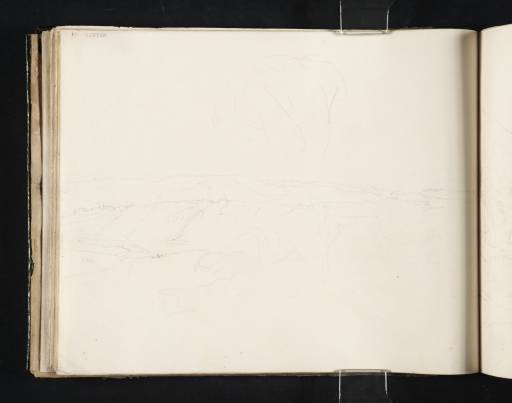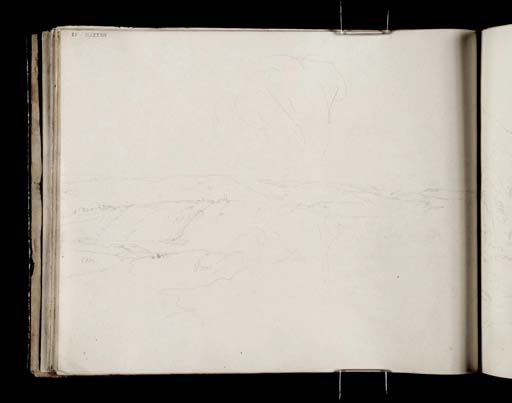Joseph Mallord William Turner The Tamar Valley towards Calstock Church, from near Gunnislake ?1813
Image 1 of 2
Joseph Mallord William Turner,
The Tamar Valley towards Calstock Church, from near Gunnislake
?1813
Joseph Mallord William Turner 1775–1851
Folio 51 Recto:
The Tamar Valley towards Calstock Church, from near Gunnislake ?1813
D10274
Turner Bequest CXXXVII 48
Turner Bequest CXXXVII 48
Pencil on white wove paper, 181 x 228 mm
Inscribed by Turner ‘corn’ centre left and ‘w’ right of centre
Inscribed by John Ruskin in red ink ‘48’ top left, upside down
Stamped in black ‘CXXXVII 48’ top left, upside down
Inscribed by Turner ‘corn’ centre left and ‘w’ right of centre
Inscribed by John Ruskin in red ink ‘48’ top left, upside down
Stamped in black ‘CXXXVII 48’ top left, upside down
Accepted by the nation as part of the Turner Bequest 1856
References
1909
A.J. Finberg, A Complete Inventory of the Drawings of the Turner Bequest, London 1909, vol.I, p.395, CXXXVII 48, as ‘Distant hills’.
This sketch of distant hills with a tower at the centre of the first ridge was used for the upper background of Turner’s large painting Crossing the Brook, exhibited in 1815 (Tate N00497).1 It shows Calstock Church from rising ground north of Gunnislake, looking south down the meandering Tamar Valley in the direction of Torpoint, Mount Edgcumbe (some twelve or more miles away) on the coast east of Plymouth.
The precise viewpoint is difficult to establish, as are identifications of any particular landmarks besides the church and the ridge hiding the village of Calstock, largely because of the conifer plantations which now characterise the area of extensive former mine workings on the slopes above Gunnislake, and the general increase in tree cover. A sense of the view can be obtained from the lanes near Rubbytown Farm and the Horn of Plenty Hotel, respectively north and north-east of Gunnislake, either side of the old Wheal Emma mine.
Despite discussing and reproducing the drawing of Gunnislake on folio 50 verso opposite (D10273; CXXXVII 47a),2 which also includes the church tower and informed the middle distance painting, the authors of a detailed study of the setting of Crossing the Brook do not mention the present sketch, stating their regret at not finding the exact viewpoint (the foreground of which is probably a combination of local features or an invention). They do reproduce modern, distant photographs of the overall view, taken in the vicinities of Wheal Emma and the nearby Wheal Josiah.3 The painting seems to combine the lower viewpoint of the sketch opposite, where the church is seen from below on the skyline, and the loftier view here, which gives a sense of far distances beyond the tower. A third study, including Gunnislake and Calstock Church framed by trees suggestive of those in the painting, is on folio 49 verso (D10271; CXXXVII 46a).
The sketchbook contains numerous views in and around the Tamar and Tavy valleys between folios 46 verso (D10265; CXXXVII 43a) and 58 verso (D10289; CXXXVII 55a), probably made in the summer of 1813 in conjunction with those in the smaller Devon Rivers, No.1 sketchbook (Tate; Turner Bequest CXXXII). The latter is covered in the section of the present catalogue specifically devoted to Turner’s 1813 visit to Devon, where further information on Turner’s work in the locality will be found.
Matthew Imms
May 2011
How to cite
Matthew Imms, ‘The Tamar Valley towards Calstock Church, from near Gunnislake ?1813 by Joseph Mallord William Turner’, catalogue entry, May 2011, in David Blayney Brown (ed.), J.M.W. Turner: Sketchbooks, Drawings and Watercolours, Tate Research Publication, December 2012, https://www


